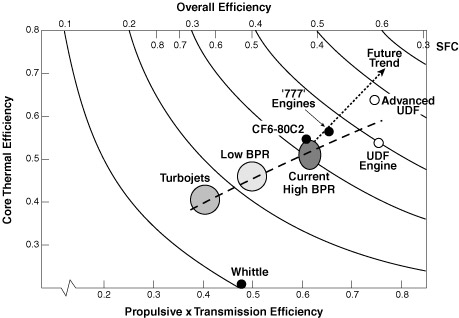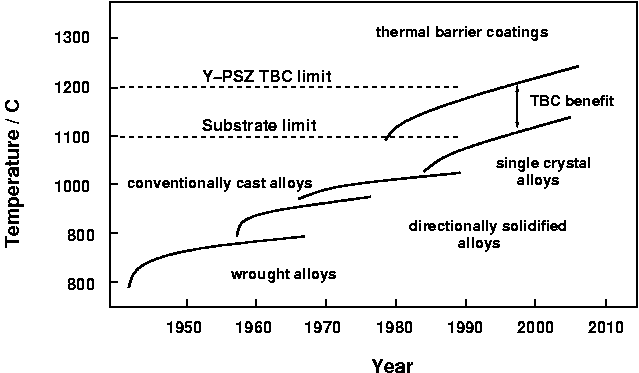

Evolution in engine efficiency, after Pratt & Withney. Obtained from this page.
Increase in operational temperature of turbine components. After Schulz et al, Aero. Sci. Techn.7:2003, p73-80.
| Introduction | Bond Coats | TBC | Processes | Resources | |
| [Map] [History] [The Gas Turbine] [Materials] [Degradation] [Coatings] | Back to phase-transformation home page |
Only some 60 years after the invention of the jet engines, flying has become a conventional method of transportation. Once the exclusive privilege of the super rich, it has become as much of a commonplace as a bus trip to the city centre (and in fact, the comfort and service onboard some of the cheapest airlines push the analogy further).
Yet, back in the early 1940's, many were seeing jet-powered flight as no more than a `laboratory experiment' (maybe in the same way as we may be, today, sceptical about future applications of the recent `scramjet').
These doubts were not unfounded: materials used in parts of the engine could not survive more than a few hundred hours at then relatively modest temperatures.
By the 1950's however, jet fighters were first put in combat in the sky of Korea. At the end of the 1960's, commercial jets were accepted, and by the end of the 1980's, the commercial aviation market overtook the military one.
The efficiency of commercial airliners has increased beyond all early expectations, and while it would probably be unfair to single out one factor, improvements in engine materials certainly played a key role.
 |
 |
Evolution in engine efficiency, after Pratt & Withney. Obtained from this page. |
Increase in operational temperature of turbine components. After Schulz et al, Aero. Sci. Techn.7:2003, p73-80. |
Economical and, today, environmental concerns continue to provide impetus for operating the engines at ever increasing temperatures, thereby improving the thermodynamic efficiency and reducing pollutant emissions.
In its early years, the quest for higher temperatures was dominated by materials and processes developments. The apparition of superalloys in the early 1950's, considerable amelioration in casting technologies and, in the 1960's, the cooling system for turbine blades were all major steps forward, each allowing the service temperature to be increased by 20 oC or more.
Over the past 20-30 years, alloy improvement, directional and single-crystal solidification have contributed significantly, but, arguably, the emphasis has been shifted to coating systems which have allowed an increase of gas temperature of up to 110 oC.
Coatings in gas turbine serve a variety of purposes, whether in jet engines, land-based power generation turbines or marine engines. A first requirement to operate turbines at higher temperatures was, of course, improved strength. Unfortunately, these conditions also mean severe oxidation/corrosion problems, and to make things worse, the improvement in mechanical properties of the base alloys was made at the expense of environmental resistance.
The first purpose of coatings was therefore to palliate for the poor oxidation resistance of the base alloy (aluminide, Pt-aluminide, MCrAlY). A second type of coatings applied to high-temperature parts are known as thermal barrier coatings (TBC). These are ceramic coatings with very low thermal conductivity. Despite being typically 1/5 mm thin, the allow for a drop of 100-300 oC between the gas and metal surface temperatures. Such coatings, however, are `oxygen transparent' and do not prevent oxidation of the underlying substrate.
| conditions of use | 2004 Thomas Sourmail. | Feedback greatly appreciated |